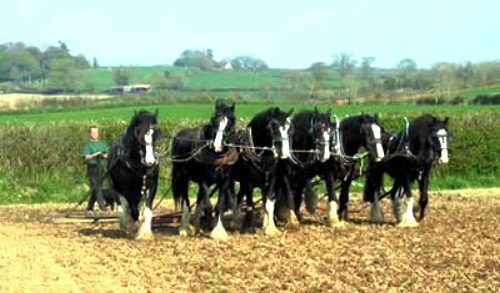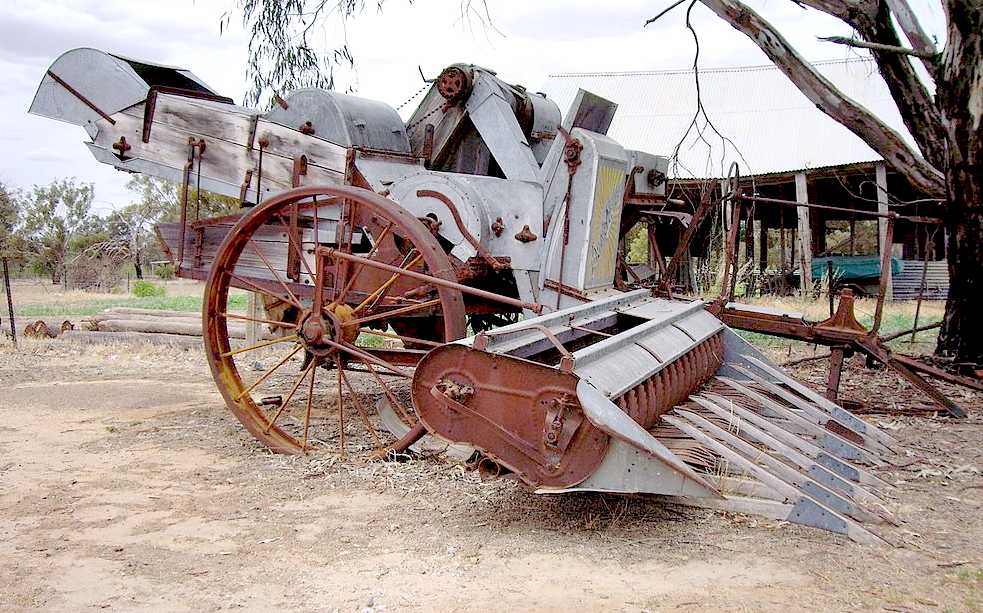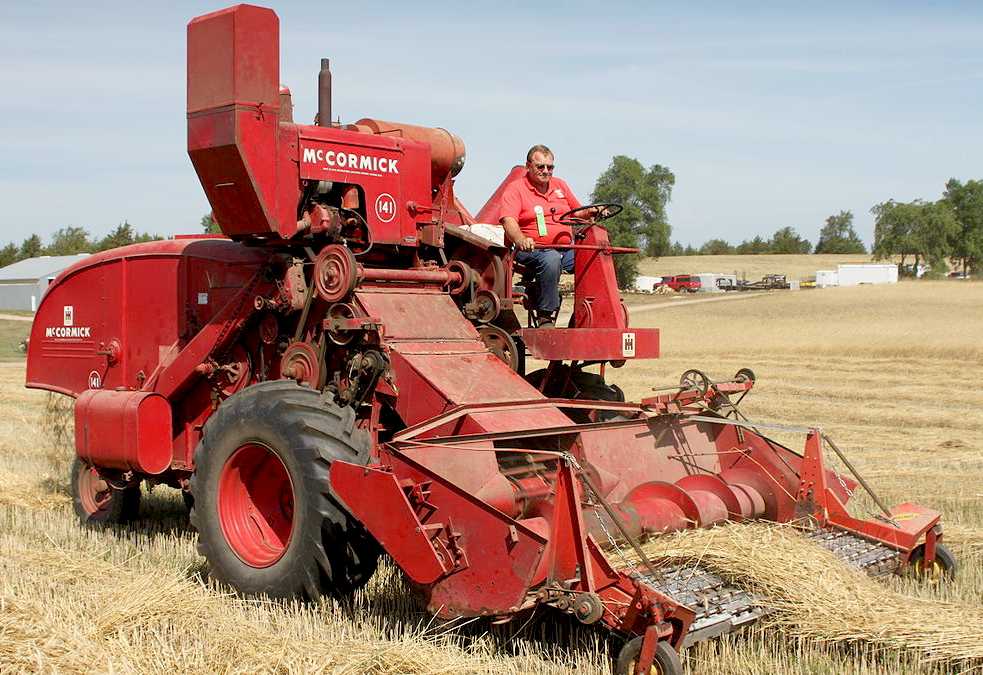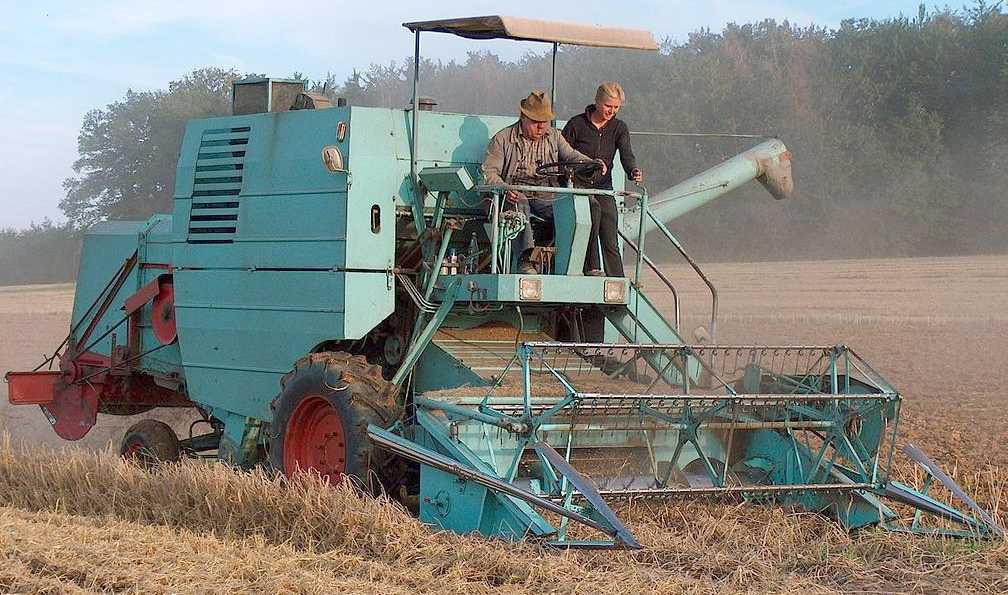
Horses
were used to plough the fields, sow the crops and harvest the grain in
days gone by. In 1800, something like 90 percent of the entire US population was employed working the
land. Fast-forward 200 years and you'll find only 2 percent of people are now working this way. What caused that amazing change in society?
As part of the industrial revolution the development of large, automated machines such as combine harvesters,
made each agricultural worker vastly more productive. This is turn
depended on a reliable portable power plant which is the internal
combustion engine. It makes you wonder then, what will happen when the
oil runs out. Will 88 percent of the population have to go back to working
on the land, or will a sustainable energy source replace agricultural red
diesel. We'd better keep those horses handy. Because, politicians have no
suggestions as to how to keep our oil based economy alive when fracking
has ruined our geological stability.
The combine harvester, or "combine," is a machine that says what
it does on the can - it harvests grain crops. The name derives from its combining three separate operations comprising harvesting
- reaping, threshing, and winnowing - into a single process. Among the crops harvested with a combine are
wheat, oats, rye, barley,
corn (maize), soybeans and flax (linseed). The waste straw left behind on the field is the remaining dried stems and leaves of the crop with limited nutrients which is either chopped and spread on the field or baled for feed and bedding for livestock.
Combine harvesters are one of the most economically important labor saving inventions, enabling a smaller fraction of the population to be engaged in
agriculture, making food cheaper to produce. Such mechanization is also
responsible for high unemployment. It is likely that as robotic methods
are introduced to farming that there will be even fewer jobs - and this is
not just in farming.
COMBINE
HISTORY
Scottish inventor Patrick Bell invented the reaper in 1826. The combine was invented in the United States by Hiram Moore in 1834, and early versions were pulled by horse or mule teams, ox. In 1835, Moore built a full-scale version and by 1839, over 50 acres of crops were harvested. By 1860, combine harvesters with a cutting width of several meters were used on American farms. In 1882, the
Australian Hugh Victor McKay had a similar idea and developed the first commercial combine harvester in 1885, the Sunshine Harvester.
Combines, some of them quite large, were drawn by mule or horse teams and used a bullwheel to provide power. Later, steam power was used, and George Stockton Berry integrated the combine with a steam engine using straw to heat the boiler. Tractor-drawn, combines became common after World War II as many farms began to use tractors. These combines used a shaker to separate the grain from the chaff and straw-walkers (grates with small teeth on an eccentric shaft) to eject the straw while retaining the grain. Early tractor-drawn combines were usually powered by a separate gasoline engine, while later models were PTO-powered. These machines either put the harvested crop into bags that were then loaded onto a wagon or truck, or had a small bin that stored the grain until it was transferred to a truck or wagon with an auger.
In the U.S., Allis-Chalmers, Massey-Harris, International Harvester, Gleaner Manufacturing Company, John Deere, and Minneapolis Moline are past or present major combine producers.
In 1911, the Holt Manufacturing Company of California produced a self-propelled harvester. In Australia in 1923, the patented Sunshine Auto Header was one of the first center-feeding self-propelled harvesters. In 1923 in Kansas, the Curtis brothers and their Gleaner Manufacturing Company patented a self-propelled harvester which included several other modern improvements in grain handling. Both the Gleaner and the Sunshine used Fordson engines. In 1929 Alfredo Rotania of Argentina
patented a self-propelled harvester. In 1937, the Australian-born Thomas Carroll, working for Massey-Harris in Canada, perfected a self-propelled model and in 1940 a lighter-weight model began to be marketed widely by the company. Lyle Yost invented an auger that would lift grain out of a combine in 1947, making unloading grain much easier.
In 1952 Claeys launched the first self- propelled combine harvester in Europe; in 1953, the European manufacturer CLAAS developed a self-propelled combine harvester named 'Herkules', it could harvest up to 5 tons of wheat a day. This newer kind of combine is still in use and is powered by diesel or gasoline engines. Until the self-cleaning rotary screen was invented in the mid-1960s combine engines suffered from overheating as the chaff spewed out when harvesting small grains would clog radiators, blocking the airflow needed for cooling.
A significant advance in the design of combines was the rotary design. The grain is initially stripped from the stalk by passing along a helical rotor instead of passing between rasp bars on the outside of a cylinder and a concave. Rotary combines were first introduced by Sperry-New Holland in 1975.
In about the 1980s on-board electronics were introduced to measure threshing efficiency. This new instrumentation allowed operators to get better grain yields by optimizing ground speed and other operating parameters.
It won't be that long before robotics
are introduced to increase efficiency even more.

Before modern-day machines were developed, agricultural workers had to harvest crops by carrying out a series of laborious operations one after another. First they had to cut down the plants with a long-handled cutting tool such as a scythe. Next, they had to separate the edible grain from the inedible chaff by beating the cut stalks—an operation known as threshing. Finally, they had to clean any remaining debris away from the seeds to make them suitable for use in a mill. All this took a lot of time and a lot of people.
RADAR
FARMING
SERVICES
RFS
do not as yet offer crop harvesting services. They tend their own land and offer
general agricultural services to other farms
in Sussex. This includes fencing, rolling, ditch clearing and many other
services involving tractors and specialist farming machinery. They also
offer strategic planning and agricultural business development advice on a
confidential basis. Our expert on this subject has defended a number of
enforcement actions in the Sussex area, where permitted development rights
had become a contentious issue, or where SSSI
status has led to heavy handed prosecutions for, essentially, exercising a
permitted development.
Our advice is to negotiate in the first
instance, to prevent enforcement that may not be appropriate. If you find
yourself in trouble, with legal bills mounting, send us an email. The longer you leave it, the more
chance you will find your farm blighted and the more it is likely to cost
you. You need to fight fire with fire. Natural
England are likely to try to bankrupt you or otherwise get a charge on
your land - to be able to control it. Council's
also operate is a similar way.
RFS
CONTACTS
The
Farm Manager
Radar
Farm Services Ltd
Wartling
Road
Pevensey
Levels
BN27
1SA
Email:
farming@bushywood.com

IH McCormick 141 Combine ca. 1954-57
RAF
HERSTMONCEUX, RAF PEVENSEY
& RAF WARTLING
Radar
Farm is part of the Home Chain system that prevented Germany from
occupying England during World War Two. you can read more about the
ingenious emplacements and operations using the above links.

New Holland Agriculture is
challenging Claas, John Deere and the rest of the harvesting industry by releasing the CR10.90 – the world's most powerful combine harvester with a chaff-smoking 652 horsepower (486 kW) to upset the competition.
Combine harvesters have been a very significant part of the global industrial revolution. Today, the US agriculture sector is more productive, while using only some 2.4 percent of the workforce, according to the University of California, Riverside.
The combine harvester has saved the human
species an awful lot of work. Its gigantic cutting head clips the grain-bearing heads off the wheat stalks and sucks them up into a threshing machine that essentially beats
the wheat ears to knock the grains out. Then it bounces and shakes the wheat around to separate the grain from the husks and
directs each component to a different outlet so that the grains can be collected for milling, and the chaff can be used as
feed for livestock or simply discarded.
The CR10.90 is the new world class 'Big Daddy' of the combine harvesting
world. It has a 16-liter, six-cylinder inline diesel
engine, the Cursor 16, pumping out a massive 652 horsepower (486 kW), and a 14,500 liter grain storage tank.
A machine this large and heavy could easily crush the soil beneath it to the point where growing further crops could be very difficult. So to combat this, New Holland has fitted the CR10.90 with a SmartTrax flexible track fitted with Terraglide suspension – a combination that allows the track to conform to the surface of the field as closely as possible, distributing the harvester's weight over a large, broad footprint.
LINKS
& REFERENCE
Ocean
combined plastic harvester
Wikipedia
Combine_harvester
https://www.gov.uk/keeping-horses-on-farms
http://www.fwi.co.uk/business/horsemeat-scandal/
28
days later RAF-Wartling-R3-GCI-ROTOR-Radar-Station-12-7-07
Subbrit
Wartling index
Subbrit
Wartling_r7
Subbrit
Pevensey_chain_home
Gizmag
New Holland cr1090 worlds most powerful combine harvester
Deere
AU products equipment combines
Explainthatstuff
how combine harvesters work
http://www.gizmag.com/new-holland-cr1090-worlds-most-powerful-combine-harvester/33211/
https://www.deere.com/en_AU/products/equipment/combines/combines.page
http://www.explainthatstuff.com/howcombineharvesterswork.html
https://www.youtube.com/watch?v=_zZgkyWxIWI
http://en.wikipedia.org/wiki/Combine_harvester
http://www.28dayslater.co.uk/forums/showthread.php/16796-RAF-Wartling-R3-GCI-ROTOR-Radar-Station-12-7-07
http://www.subbrit.org.uk/rsg/sites/w/wartling/index1.html
http://www.subbrit.org.uk/rsg/sites/w/wartling_r7/
http://www.subbrit.org.uk/sb-sites/sites/p/pevensey_chain_home/index.shtml

A Lely open-cab combine




